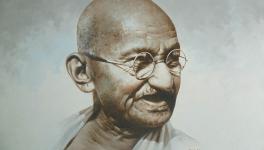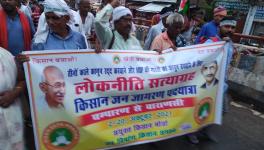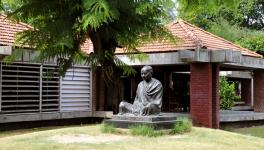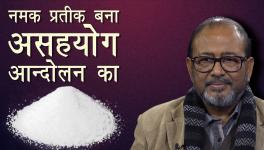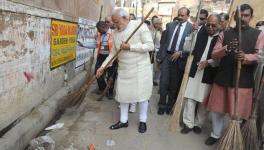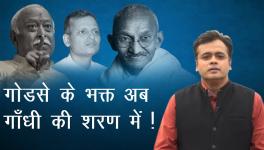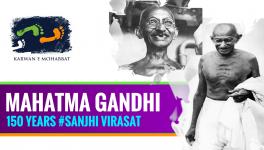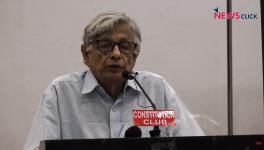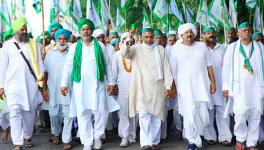This Gandhi Jayanti, Media Should Not Spin Lies in His Name
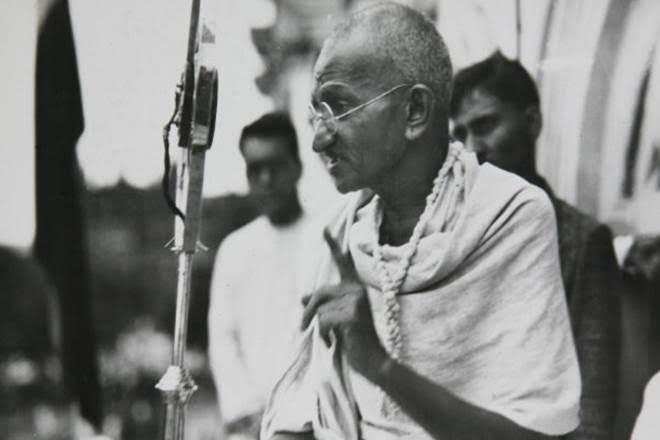
Reams and reams of newsprint have been expended to spin stories around Mahatma Gandhi and analyse his ideas to celebrate his 150th birth anniversary on October 2, which is the date the mainstream media have traditionally used as a bait to lure corporate sponsorship. Yet, their fishing for revenue in the name of Gandhi appears astonishingly hypocritical today because of their increasing reluctance to speak truth to power and lack of spunk to resist the State’s manipulation.
Gandhi would have undoubtedly preferred the media to live his ideas, of which disobedience was among the defining ones, than to analyse them threadbare.
Celebration was meaningless for Gandhi unless it had a larger national purpose, which was to be realised through action. This was why he turned his own birthday into an occasion to spin yards and yards of yarn. For him, the charkha symbolised freedom from poverty and, therefore, slavery.
Indeed, the media should take a cue from Gandhi to identify the larger national purpose behind celebrating his birth anniversary. To do so, journalists need to study how he creatively re-imagined his birthday celebration.
Gandhi’s indifference to his own birthday celebration is palpable in his writings. For instance, in an appeal to the people to engage in spinning, published in The Hindustan Times of September 29, 1939, Gandhi said: “I have no love for the celebration of my birthday. Any other day is as good or bad as a birthday. My parents, so far as I recollect, never celebrated the birthdays of their children. I remember the date of my birthday only because I had to take the birth certificate for the London examination [to do law]. But I never thought of the date until after the rebirth of khadi.”
Yet Gandhi was extremely conscious of the courtesy of wishing luminaries on their birthday. In South Africa, he and his comrades sent cables to the colonial secretary, in Pietermaritzburg, requesting him to convey their birthday greetings to Queen Victoria and, later, to King Edward VII.
He wrote articles in the Indian Opinion, a weekly newspaper he published, lavishing praise on Dadabhai Naoroji, who was popularly known as the Grand Old Man of India, on his birthday – September 4 -- every year. On his return to India in 1915, Gandhi presided over several birthday celebrations of Annie Besant, an ardent supporter of self-rule for India, and of the saint-philosopher Shrimad Rajchandra.
But history was already in the making; there was no escape for Gandhi from public adulation and birthday celebration. For instance, on October 2, 1917, Besant unveiled the portrait of Gandhi in Gokhale Hall, Madras. Two years later, on October 2,1919, the Bhagini Samaj, a women’s organisation, held a reception for Gandhi at Vanita Vishram Hall, Bombay, and presented him a purse of Rs 21,100.
Even before the felicitation in Bombay, people had taken to thronging his Sabarmati Ashram, Ahmedabad, to greet him on his birthday, as they did on October 1, 1918. Why October 1? That was because, according to the Vikram Samvat calendar followed in Gujarat, Gandhi was born on the 12th day of the waning of the moon in the month of Bhadarva. The day, known as Bhadarva Vad 12, falls in the latter part of September or early October. The date shifts every year as the Vikram Samvat calendar is primarily a lunar-based calendar. Gandhi’s 150th birthday, by the Gujarati calendar, was on September 26.
On Bhadarva Vad 12, the Gujarati was traditionally expected to work on the spinning wheel, or Rentia, to produce yarn. Bhadarva Vad 12 was called Rentia Baras in the local parlance. Adept at reinterpreting traditions, Gandhi turned his birthday into a day of working the charkha. It soon became the norm among Gandhi’s followers to spin yarn for celebrating Gandhi’s birthday on both Bhadarva Vad 12 and October 2.
Gandhi’s nephew, Narandas Gandhi, who was also the manager of the Sabarmati Ashram, hit upon the idea of organising ‘Khadi Week’, which involved nearly continuous spinning between Bhadarva Vad 12 and October 2. The nephew began to multiply Gandhi’s age by a thousand to increase the target of production every year. Thus, on Gandhi’s 66th birthday, 66,000 yards of yarn were produced; on his 70th birthday a whopping 70,000 yards. Gandhi gave Narandas the sobriquet of “khadi-mad.”
In the 1939 appeal published in The Hindustan Times, a delighted Gandhi wrote: “Khadi-lovers made the date of my birth an occasion for pushing khadi sales. I did not mind such exploitation of my birthday but tried with more or less success to give it the name of Rentia Jayanti so far as the Gujarati-speaking public was concerned.”
In the Harijan, a weekly journal which Gandhi published, he wrote in 1942: “Gandhi Jayanti is just a pretext, the real thing is Charkha Jayanti. Had there been no charkha, there would perhaps have been no Jayanti (Birthday) celebrations, and even if there had been such celebrations, they would have had little importance.”
Despite turning October 2 and Bhadarva Vad 12 into occasions for celebrating the spinning of yarn, Gandhi remained perplexed about the human tendency to celebrate birthdays. In a 1945 letter greeting Harshada Diwanji on her birthday, Gandhi, tongue-in-cheek, wrote: “You have not mentioned how many years you have completed. Whatever the number, don’t you have now so many years less to live? From this point of view, we should mourn on our birthday.” He harped on this in several of his correspondences with others as well.
Yet he did not forget to greet his comrades on their birthday. On November 12, 1944, VK Krishna Menon was sent a cable by Gandhi that was to be communicated to Jawaharlal Nehru, who was then in prison, on November 14, his birthday. The cable read: “Jawaharlal is a jewel among men. Happy is the land that owns him.”
In 1945, The Hindu reported Gandhi wishing Rajendra Prasad on his birthday – December 3 -- with a pithy message: “Rajendra Prasad is a true patriot. Long live Rajendra Prasad.” In the same year, when a correspondent asked Gandhi what message he had for Sardar Vallabhbhai Patel on his birthday, he replied, “Sardar is as dear as a son to me. What message can a father give to a son?”
What Gandhi opposed was a show of adulation on his birthday. In a note to Sarvepalli Radhakrishnan, Gandhi warned against declaring his birthday as a holiday. To another letter-writer from Amravati, he wrote: “To declare my birthday a holiday should be classified as a cognizable offence. The only use of my birthday that I have approved of is intensive spinning or some such national service.”
Might not the media emulate Gandhi and treat October 2, as a pretext to strive for a lofty ideal? What could that ideal be? For identifying that, journalists should turn to the speech Gandhi delivered on October 2, 1947 -- his last birthday.
Gandhi said he no longer wished to live for 125 years, as he had often in the past expressed a desire to do. “For me, today is the day of mourning. I am surprised and also ashamed that I am still alive,” Gandhi said, referring to the Partition riots ravaging the country. He said that he had now stopped thinking about living for 125, 100 or even 90 years because of the bestiality of men on display. “I am entering my 79th year today; but even that pains me,” he said.
Earlier in the speech, Gandhi had reminded the audience about his unusual method of celebrating his birthday -- that of fasting, spinning and praying. But now he beseeched them, “If you really want to celebrate my birthday, it is your duty not to let anyone be possessed by madness and if there is any anger in your hearts you must remove it.”
Prime Minister Narendra Modi has shown a penchant for celebrating Gandhi Jayanti by training the spotlight on important issues. For instance, Modi launched his project of Swachh Bharat on October 2. This year, he is to kick-start a project to free India of single-use plastic. A clean, plastic-free India does indeed have a larger national purpose. Yet the same government and the ruling Bharatiya Janata Party have used the cow, the National Register of Citizens and Kashmir, among other measures, to consciously ensure the nation is possessed by precisely what Gandhi called “madness.”
Perhaps October 2 is just the day for the media to think of a method to tackle the “madness”, to expose Modi’s use of Gandhi to promote a plastic-free India, which is, at the same time, divided daily through the tactics of pushing divisive issue. But then, it might be too much to expect the media to develop a spine overnight. For starters, therefore, instead of analysing Gandhi’s ideas, journalists should spin out, in the manner of Narandas, a list of 150 truths they concealed from their readers. Even a list of 50 would do.
Ajaz Ashraf is a freelance journalist based in Delhi. Views are personal.
Get the latest reports & analysis with people's perspective on Protests, movements & deep analytical videos, discussions of the current affairs in your Telegram app. Subscribe to NewsClick's Telegram channel & get Real-Time updates on stories, as they get published on our website.









